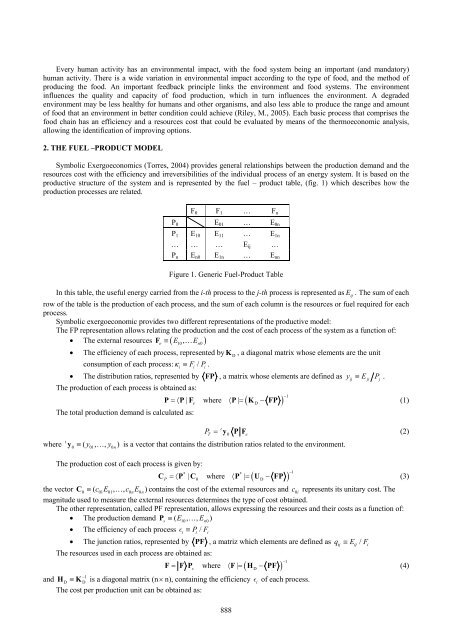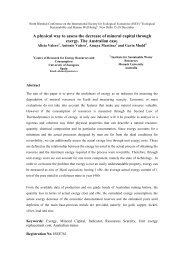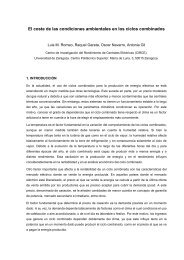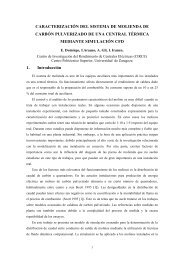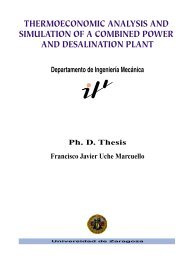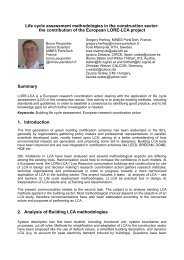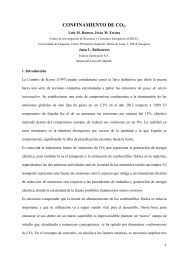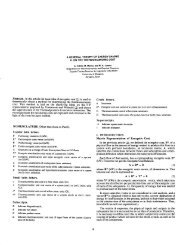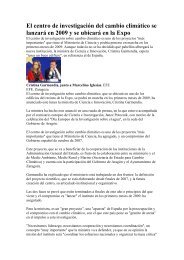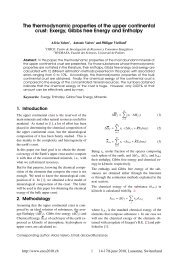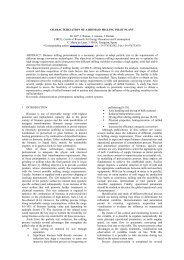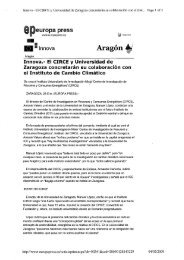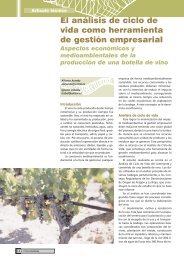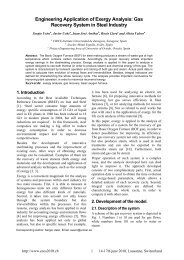APPLYING THERMOECONOMICS TO THE ANALYSIS OF ... - circe
APPLYING THERMOECONOMICS TO THE ANALYSIS OF ... - circe
APPLYING THERMOECONOMICS TO THE ANALYSIS OF ... - circe
Create successful ePaper yourself
Turn your PDF publications into a flip-book with our unique Google optimized e-Paper software.
Every human activity has an environmental impact, with the food system being an important (and mandatory)<br />
human activity. There is a wide variation in environmental impact according to the type of food, and the method of<br />
producing the food. An important feedback principle links the environment and food systems. The environment<br />
influences the quality and capacity of food production, which in turn influences the environment. A degraded<br />
environment may be less healthy for humans and other organisms, and also less able to produce the range and amount<br />
of food that an environment in better condition could achieve (Riley, M., 2005). Each basic process that comprises the<br />
food chain has an efficiency and a resources cost that could be evaluated by means of the thermoeconomic analysis,<br />
allowing the identification of improving options.<br />
2. <strong>THE</strong> FUEL –PRODUCT MODEL<br />
Symbolic Exergoeconomics (Torres, 2004) provides general relationships between the production demand and the<br />
resources cost with the efficiency and irreversibilities of the individual process of an energy system. It is based on the<br />
productive structure of the system and is represented by the fuel – product table, (fig. 1) which describes how the<br />
production processes are related.<br />
F0 F1 … Fn<br />
P0 E01 … E0n<br />
P1 E10 E11 … E1n<br />
… … … Eij …<br />
Pn En0 E1n … Enn<br />
Figure 1. Generic Fuel-Product Table<br />
In this table, the useful energy carried from the i-th process to the j-th process is represented as E ij . The sum of each<br />
row of the table is the production of each process, and the sum of each column is the resources or fuel required for each<br />
process.<br />
Symbolic exergoeconomic provides two different representations of the productive model:<br />
The FP representation allows relating the production and the cost of each process of the system as a function of:<br />
F ≡ E , … E<br />
• The external resources ( )<br />
e 10 n0<br />
• The efficiency of each process, represented by K D , a diagonal matrix whose elements are the unit<br />
•<br />
consumption of each process: κi ≡ Fi / Pi<br />
.<br />
The distribution ratios, represented by FP , a matrix whose elements are defined as yij ≡ EjiPj. The production of each process is obtained as:<br />
( ) 1<br />
P =〈 P| Fe The total production demand is calculated as:<br />
where 〈 P| = KD− −<br />
FP (1)<br />
t<br />
P T = y0P F e<br />
(2)<br />
y ( , , ) is a vector that contains the distribution ratios related to the environment.<br />
t<br />
where 0 ≡ y01 … y0n<br />
The production cost of each process is given by:<br />
*<br />
CP=〈 P | C0where *<br />
〈 P | = ( UD−<br />
−1<br />
FP )<br />
(3)<br />
the vector C0 ≡ ( c01E01, …, c0nE0n) contains the cost of the external resources and c 0i represents its unitary cost. The<br />
magnitude used to measure the external resources determines the type of cost obtained.<br />
The other representation, called PF representation, allows expressing the resources and their costs as a function of:<br />
• The production demand P s ≡ ( E10, …,<br />
En0)<br />
• The efficiency of each process i i / i F P ≡ ε<br />
• The junction ratios, represented by PF , a matriz which elements are defined as qij ≡ Eij/ Fi<br />
The resources used in each process are obtained as:<br />
( ) 1<br />
F = F Pswhere 〈 F | = HD−<br />
−<br />
PF (4)<br />
−1<br />
and HD ≡ K D is a diagonal matrix (n× n), containing the efficiency ε i of each process.<br />
The cost per production unit can be obtained as:<br />
888


